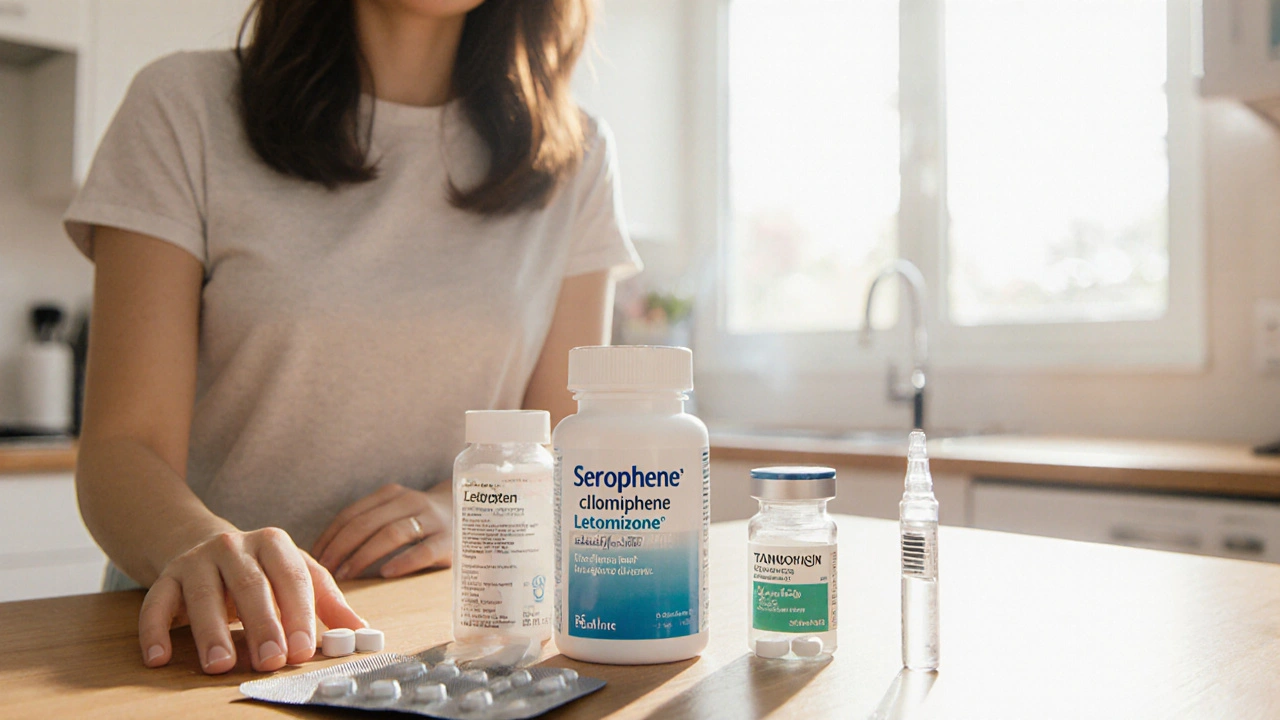Serophene vs. Alternative Fertility Drugs Comparison Tool
Serophene (Clomiphene)
A selective estrogen receptor modulator (SERM) that blocks estrogen receptors to stimulate ovulation. Often the first-line treatment for unexplained infertility.
- Mechanism: Blocks estrogen receptors
- Success Rate: 60-70% per cycle
- Cost: $30-$50 per cycle
Letrozole
An aromatase inhibitor that reduces estrogen production, prompting increased FSH release. Often preferred for women over 35.
- Mechanism: Aromatase inhibitor
- Success Rate: 65-75% per cycle
- Cost: $40-$80 per cycle
Tamoxifen
Another SERM used off-label for ovulation induction, particularly when clomiphene fails.
- Mechanism: SERM - Similar to clomiphene
- Success Rate: 55-65% per cycle
- Cost: $35-$60 per cycle
Gonadotropins
Injectable hormones that directly stimulate the ovaries. Highest ovulation rates but also highest risk of multiple pregnancies.
- Mechanism: Direct hormonal stimulation
- Success Rate: 90-95% per cycle
- Cost: $400-$800 per cycle
Metformin
Used primarily for PCOS-related infertility, improving response to other ovulation-inducing drugs.
- Mechanism: Insulin sensitizer
- Success Rate: Improves other drugs' rates by ~10%
- Cost: $20-$40 per cycle
Detailed Comparison Table
| Drug | Mechanism | Typical Success Rate (per cycle) | Common Side Effects | Cost (AUD per cycle) |
|---|---|---|---|---|
| Serophene (Clomiphene) | SERM - blocks estrogen receptors | 60-70% | Hot flashes, mood swings, ovarian cysts, thin uterine lining | $30-$50 |
| Letrozole | Aromatase inhibitor - lowers estrogen production | 65-75% (higher in >35 y) | Fatigue, joint pain, nausea | $40-$80 |
| Tamoxifen | SERM - similar to clomiphene | 55-65% | Vaginal discharge, visual disturbances (rare) | $35-$60 |
| Gonadotropins (FSH/LH) | Direct hormonal stimulation | 90-95% | Ovarian hyperstimulation, multiple births | $400-$800 |
| Metformin | Insulin sensitizer | Improves other drugs’ rates by ~10% | Gastrointestinal upset, metallic taste | $20-$40 |
Decision Tips
- Start with Serophene if you have unexplained infertility under 35
- Letrozole is often preferred for women over 35
- Try Metformin if you have PCOS
- Consider Gonadotropins if other treatments fail
When doctors prescribe Serophene is a brand name for clomiphene citrate, an oral medication used to stimulate ovulation in women with infertility. many patients wonder if it’s the best option or if another drug might fit their lifestyle better. This guide walks you through the science, success rates, side‑effects, and practical considerations so you can decide with confidence.
- Serophene (clomiphene) blocks estrogen receptors to kick‑start hormone signals.
- Letrozole, an aromatase inhibitor, lowers estrogen production instead.
- Gonadotropin injections directly supply the hormones ovaries need.
- Metformin targets insulin resistance, helpful for PCOS‑related infertility.
- Choosing the right drug depends on age, diagnosis, and how your body reacts.
What is Serophene (Clomiphene) and How Does It Work?
Clomiphene citrate is a selective estrogen receptor modulator (SERM) that tricks the brain into thinking estrogen levels are low. The hypothalamus releases more gonadotropin‑releasing hormone (GnRH), prompting the pituitary gland to secrete follicle‑stimulating hormone (FSH) and luteinizing hormone (LH). Those hormones stimulate the ovarian follicles to mature, leading to ovulation.
The typical starting dosage is 50mg daily for five days, beginning on cycle day3-5. Doctors may increase to 100mg or 150mg if ovulation doesn’t occur. Success rates hover around 60‑70% per cycle for women with unexplained infertility, and up to 80% for those with polycystic ovary syndrome (PCOS) when combined with lifestyle changes.
Major Alternatives to Serophene
Letrozole is an aromatase inhibitor that reduces estrogen synthesis, indirectly prompting the pituitary to release FSH. It’s taken for three days (2.5mg or 5mg) early in the cycle. Recent studies show comparable, sometimes higher, pregnancy rates than clomiphene, especially in women over 35.
Tamoxifen is another SERM used off‑label for ovulation induction. Its dosing mirrors clomiphene (20‑40mg daily). It can be useful when clomiphene fails, but data on live‑birth rates are limited.
Gonadotropins are injectable forms of FSH and LH that directly stimulate the ovaries. Brands like Follistim or Gonal‑F are administered subcutaneously, often in a “step‑up” protocol. They achieve the highest ovulation rates (90‑95%) but are costly and raise the risk of multiple pregnancies.
Metformin is an insulin‑sensitizing drug commonly used for type2 diabetes and PCOS. While not a primary ovulation agent, it improves clomiphene response and can be combined with low‑dose clomiphene or letrozole for better outcomes.
Other agents, like anastrozole or GnRH antagonists, exist but are used less frequently due to limited evidence or higher costs.

Side‑Effect Profile Comparison
| Drug | Mechanism | Typical Success Rate (per cycle) | Common Side‑Effects | Cost (AUD per cycle) |
|---|---|---|---|---|
| Serophene (Clomiphene) | SERM - blocks estrogen receptors | 60‑70% | Hot flashes, mood swings, ovarian cysts, thin uterine lining | $30‑$50 |
| Letrozole | Aromatase inhibitor - lowers estrogen production | 65‑75% (higher in >35y) | Fatigue, joint pain, nausea | $40‑$80 |
| Tamoxifen | SERM - similar to clomiphene | 55‑65% | Vaginal discharge, visual disturbances (rare) | $35‑$60 |
| Gonadotropins (FSH/LH) | Direct hormonal stimulation | 90‑95% | Ovarian hyperstimulation, multiple births | $400‑$800 |
| Metformin | Insulin sensitizer | Improves other drugs’ rates by ~10% | Gastrointestinal upset, metallic taste | $20‑$40 |
Decision Criteria - When to Choose Each Option
Start with your diagnosis. If you have simple unexplained infertility and are under 35, Serophene remains a solid first‑line choice because it’s cheap and easy to use. For women over 35, letrozole’s higher success in older ovaries often makes it the preferred oral agent.
If you’ve already tried clomiphene for two cycles without ovulation, consider swapping to letrozole or adding metformin if PCOS is present. Persistent failure after both oral drugs usually pushes clinicians toward gonadotropin injections, especially if you have a good ovarian reserve and can tolerate frequent monitoring.
Cost and convenience matter too. In Australia, the out‑of‑pocket expense for clomiphene is a fraction of injectable therapy. However, if you’re willing to invest in a higher success rate and have access to a fertility clinic with monitoring, gonadotropins become attractive.
Safety preferences shape the choice. Women who experienced severe hot flashes or mood swings on clomiphene often report fewer hormonal swings on letrozole. Those at risk of multiple pregnancies (e.g., a history of twins) might avoid high‑dose gonadotropins.
Practical Checklist for Patients
- Confirm your fertility diagnosis (PCOS, unexplained, age‑related).
- Discuss any history of ovarian cysts or endometrial issues with your doctor.
- Ask about baseline hormone levels (FSH, LH, estradiol, AMH).
- Consider a trial of clomiphene for 3‑4 cycles; note ovulation and side‑effects.
- If no ovulation, switch to letrozole or add metformin.
- For high‑response or multiple‑egg goals, discuss gonadotropin protocols.
- Track side‑effects daily; report severe hot flashes, visual changes, or abdominal pain.
- Calculate total cost per cycle, including monitoring ultrasounds.
- Plan for a backup method (IUI or IVF) if oral agents don’t work within 6 cycles.

Frequently Asked Questions
Can I take Serophene and letrozole together?
Combining the two isn’t recommended because they act on the same hormonal pathway and increase the risk of ovarian hyperstimulation. Doctors may prescribe metformin alongside clomiphene or letrozole, but not both drugs at the same time.
How long does it take to see results with Serophene?
Ovulation usually occurs 5‑10 days after the last tablet. Pregnancy can be detected about two weeks later, so many patients know whether a cycle was successful within 3‑4 weeks.
Is it safe to use Serophene if I have a thyroid disorder?
Thyroid issues can affect hormone balance, but clomiphene itself doesn’t directly interfere with thyroid medication. Still, your endocrinologist should confirm your thyroid levels are stable before starting any fertility drug.
What are the chances of twins with Serophene?
Twin pregnancies occur in roughly 7‑10% of clomiphene cycles, higher than the natural rate of about 1‑2%. If twins are a concern, doctors may lower the dose or switch to a different agent.
Do I need regular ultrasounds while on these drugs?
Yes. Monitoring ensures follicles aren’t growing too fast, which could lead to hyperstimulation. Ultrasound timing varies: typically on day10-12 of the cycle for clomiphene and letrozole, and earlier for gonadotropin injections.
Choosing the right ovulation‑induction drug is a balance of effectiveness, side‑effects, cost, and personal comfort. By understanding how Serophene works, where it shines, and what alternatives offer, you can have a focused conversation with your fertility specialist and pick the path that aligns with your goals.





Oliver Bishop - 2 October 2025
Honestly, the cost difference between clomiphene and the pricier injectables is massive, and for most folks under 35 the cheap pill works just fine. It’s a solid first‑line choice if you’re looking to keep the budget in check while still getting decent odds.
Alissa DeRouchie - 3 October 2025
I feel like everyone’s treating Letrozole like the holy grail but honestly it’s just another pill that makes you wonder why we keep chasing the next miracle drug the side effects are real and the hype is overblown. Sure the success rates look better on paper but the joint pain and nausea have me questioning if it’s worth the drama you’re always hearing about.
Emma Howard - 4 October 2025
Great breakdown! This really helps anyone trying to pick a drug-thanks for the clarity! 🙌
dee gillette - 5 October 2025
While the data presented favor clomiphene for younger patients, I would contest the blanket recommendation, as individual pharmacogenomic variations can markedly alter efficacy, thereby necessitating a more personalized approach.
Jasin P. - 6 October 2025
Ah, the grand theater of fertility meds-everyone loves a good plot twist, doesn’t they? You think clomiphene is just a cheap pill you pop and hope for the best, but the reality is a little more dramatic. The hot flashes? Pure fireworks that your body throws for no good reason. Mood swings? As if you needed another reason to question your sanity. And let’s not forget the ovarian cysts that pop up like unwanted guests at a party. Sure, the success rate looks decent on paper, but have you considered the emotional toll of watching your cycle dance around a thin uterine lining? If you’re over 35, letrozole walks in like the seasoned hero with a slightly better track record, yet it brings its own set of aches and joint pains. Gonadotropins? Those are the high‑stakes gamblers-huge odds, huge price, and a scary chance of twins. Metformin slides in quietly, pretending to be the sidekick, but it only helps if you have PCOS. Bottom line: there’s no one‑size‑fits‑all, and picking a drug is less about hype and more about personal biology and how much drama you’re willing to endure.
Lily Đàn bà - 7 October 2025
Don’t waste your money on fancy shots when a cheap pill does the job.
Joseph O'Sullivan - 8 October 2025
Mate, you’re missing the nuance-those “fancy shots” can actually double success rates if you’re willing to monitor properly and accept the risk.
Conor McCandless - 9 October 2025
The history of ovulation induction reads like a saga of human ambition.
From ancient herbs to modern synthetics we have chased fertility like a mythic quest.
Clomiphene arrived as a miracle for the masses and quickly became the workhorse of reproductive clinics.
Its mechanism of tricking the brain into thinking estrogen is low is elegant and simple.
Yet the very simplicity hides a cascade of side effects that can haunt patients for months.
Hot flashes, mood swings, and thin uterine lining are the unwanted companions of many.
Letrozole entered the stage promising higher success for older women and delivered on some fronts.
Its aromatase inhibition reduces estrogen, allowing a more natural follicular growth in many cases.
But the joint pain and nausea it brings are not to be dismissed lightly.
Gonadotropins, the injectable titans, push the ovary to its limits with astounding ovulation rates.
The price tag of these hormones rivals a small car and the risk of multiple births looms large.
Metformin, originally a diabetes drug, finds its place as a supportive actor for PCOS patients.
It does not trigger ovulation alone but improves the response to other agents.
The choice among these drugs should be guided by age, diagnosis, cost tolerance, and personal comfort with monitoring.
In the end the physician and patient must co‑author the treatment plan, weighing success against side effects and financial burden.
kat gee - 10 October 2025
Wow, that was epic – you really turned a drug guide into a saga. Thanks for the drama.
Iain Clarke - 11 October 2025
If you’re comparing costs, remember that the price of injectables often includes the necessary monitoring ultrasounds, so the total expense may be higher than the pill alone.
Courtney Payton - 12 October 2025
i think you oversimplify the “budget” argument many patients cant afford even the cheap clomiphene when insurance doesn't cover it.